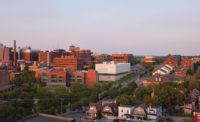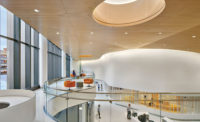A cherished pillar of Washington, D.C.’s LGBTQ community, the nonprofit Whitman-Walker Health (WWH) has grown significantly since its establishment in 1978 as a free STD clinic for gay men. Now WWH offers a broad range of LGBTQ health care and social services at several locations throughout the city and benefits almost 16,000 people annually. In 2012, as part of a capital effort to better serve a client base that had doubled over the previous six years, WWH began a search for a space that could house comprehensive care services. In 2013 it leased a planned six-story, 42,000-square-foot building just two blocks south of the Elizabeth Taylor Medical Center—WWH’s primary location—in the Dupont-Logan neighborhoods that have been the heart of D.C. gay life for decades. The nonprofit turned to the D.C. office of Perkins+Will (P+W) to bring its vision to life.
The designers’ challenge? Creating a health-care facility in what the shell and core architects—local firm Eric Colbert & Associates—had originally envisioned as a boutique office mid-rise with a ground-floor restaurant. As the building’s construction hadn’tstarted, P+W was able to coordinate several changes, says project designer David Cordell, including dental-chair drain lines and certain slab penetrations, before the concrete was poured. The most significant alteration, however, was to the bathroom core: Whitman-Walker’s desire for all restrooms to be gender-neutral proved something of an interiordesign puzzle. “The fixture count stayed the same,” says Cordell, “but we had to be incredibly efficient with the layout to keep the overall footprint from growing.”
Taking cues from a pre-occupancy survey of staff and patients, the new Whitman-Walker Health center follows a “medical home” model, says Cordell, “where all health-care needs are taken care of in one place.” Services are grouped by floor, with two teams of providers occupying each of the four stories dedicated to patient care. The top floor houses administrative offices and meeting spaces, and, at street level, P+W designed a cheerful pharmacy inspired by the brightly lit, openplan drugstore design found throughout Europe. “The pharmacy is a big revenue source” for WWH, says Cordell, and aims to serve the general community as well, so the space was given extra design attention to enable it to compete with nearby pharmacies.
The $9.8 million facility, fully funded by WWH, opened in 2015. According to Cordell, the design has been highly successful, doubling Whitman-Walker’s medical-exam-room capacity, tripling its dental program, and providing ample space for wellness programs, including massage therapy and yoga classes. But WWH isn’t done repositioning itself as a leading provider of LGBTQ health care: it’s already tapped P+W to lead the interior design efforts as the organization redevelops its existing R Street complex into a large, mixed-use building that will include 30,000 square feet of administrative offices, space for clinical services, and a new community center.
Read more about how acoustic interventions at WWH help to preserve patient privacy in the January/February issue of SNAP.







Post a comment to this article
Report Abusive Comment